
Medical imaging technologies are continuously evolving. Among the methods used for diagnosis and treatment planning, fluoroscopy holds a special place by allowing real-time observation of moving structures. So, what is fluoroscopy, how is it applied, and in which cases is it used? In this article, we explore all the details you might wonder about fluoroscopy.
What Is Fluoroscopy?
Fluoroscopy is a specialized radiological examination that provides live X‑ray imaging of internal structures. With this method, doctors can observe organ movement, fluid flow, or the placement of medical devices within the body in real time. It is especially important for examining the digestive and urinary systems, vascular structures, bones, and joints. This live view enables more accurate diagnosis and even real‑time intervention if needed.
Why Is Fluoroscopy Performed?
Unlike static X‑rays, fluoroscopy offers continuous, dynamic imaging, allowing observation of changing physiological processes. It is particularly useful for:
- Detecting blockages or reflux in the digestive system
- Evaluating swallowing difficulties (e.g., with barium swallow tests)
- Identifying urinary tract obstructions
- Examining heart valves and blood vessels
- Guiding medical devices like catheters, stents, or balloons
- Assessing joint mobility
- Ensuring accuracy of spinal injections
How Is Fluoroscopy Performed?
Fluoroscopy is conducted in radiology departments using specialized equipment, often with contrast agents to enhance image clarity. The procedure typically follows these steps:
- Preparation: Patients may be asked to fast or adhere to a specific diet. For example, a 6–8 hour food restriction is common for stomach or bowel imaging.
- Contrast Administration: Contrast (such as barium) may be given orally, intravenously, or rectally depending on the area of interest.
- Positioning and Monitoring: The patient is positioned before the fluoroscopy unit, and the physician watches the live images on a monitor. Multiple angles may be captured.
- Procedure Time: Duration varies; it can take 10 minutes for simple exams or up to 30–40 minutes for complex evaluations.
In Which Areas Is Fluoroscopy Used?
Fluoroscopy is widely used across multiple specialties:
- Gastroenterology:
- Barium swallow (esophagus)
- Barium meals and bowel studies
- Reflux evaluation
- Urology:
- Imaging urinary tract and bladder (cystourethrography)
- Detecting ureteral obstruction
- Orthopedics:
- Assessing joint range of motion
- Guiding injections or aspirations
- Cardiology:
- Evaluating heart valve function
- Guiding balloon or stent placements
- Interventional Radiology:
- Catheter positioning
- Precisely locating biopsy sites
Advantages of Fluoroscopy
- Real-time monitoring of organ movement and fluid flow
- More accurate diagnoses with dynamic imaging
- Procedural guidance, especially in interventional cases
- Quick and efficient, often completed in one session
- Same-day discharge for outpatient procedures
Is Fluoroscopy Risky?
Fluoroscopy uses X‑rays, exposing patients to a low dose of radiation, which is medically considered safe. Physicians optimize image quality while minimizing exposure. Contrast agents may rarely cause allergic reactions, so patients should inform their doctor if they have a history of allergies.
After Fluoroscopy: What to Watch For
After the procedure, patients are advised to drink plenty of water to eliminate contrast material. If barium is used orally, stool may appear lighter for a few days. Contact your physician if you experience severe pain, abdominal cramps, fever, or vomiting.
Fluoroscopy is one of the few modalities that allows live visualization of organs and devices. It greatly facilitates diagnosis, surgical planning, and minimally invasive procedures. If your doctor recommends fluoroscopy, don’t hesitate to ask why it’s needed and how it works. Being an informed patient is the strongest step in your health care journey.